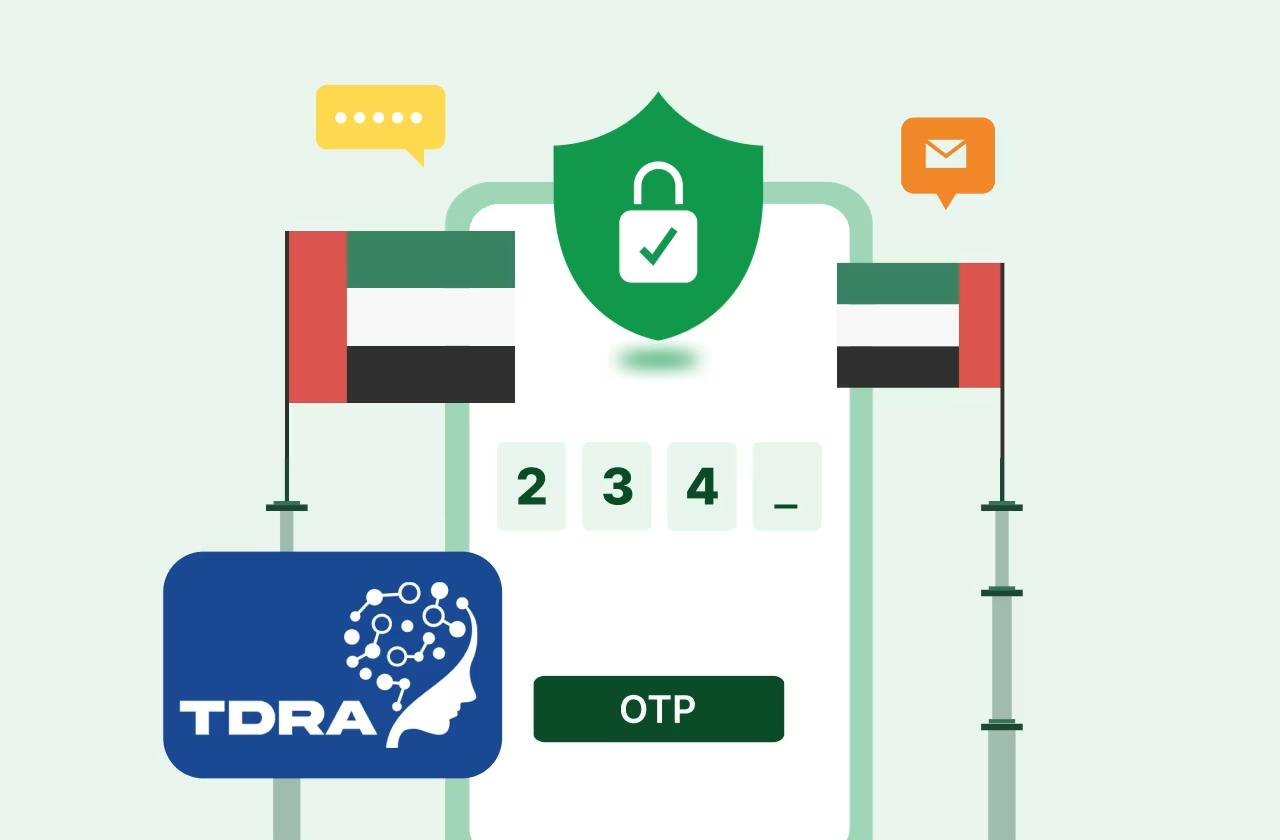Key Takeways
- OTP adds an additional layer of security and is extensively used by businesses for user authentication
- The process of OTP verification for a business should be thoroughly tested to ensure that it is not prone to vulnerabilities
- OTP testing can be categorized as positive or negative test cases
- OTP SMS can be tested on generation, delivery, expiration, input field, security, usability etc.
- A comprehensive testing is necessary to ensure fool proof user authentiction
Security of sensitive information is of paramount importance and implementing robust measures is crucial.
One such security mechanism that has gained widespread adoption is the OTP SMS (One-Time Password). OTPs are widely used for various purposes, including validating mobile numbers, email addresses, and facilitating secure transactions.
OTP SMS APIs can be used using an OTP service provider like Verify Now. With the best connectivity, Verify Now by Message Central also enable DLT SMS i.e. sending OTP SMS without any DLT registration in India. To ensure the effectiveness of OTP verification, comprehensive testing is essential.
In this article, we will explore the significance of OTP testing, its use cases, and provide a comprehensive set of test cases to ensure secure verification.
Introduction to OTP
OTP, short for One-Time Password, is a temporary password that is valid for single use or for a limited period. It is commonly used as an additional layer of security in multi-factor authentication system. OTPs can be delivered to users via SMS, email, or generated by authenticator apps. The purpose of OTP is to provide an extra level of security by requiring users to provide a unique code along with their regular login credentials.
The Importance of OTP Testing
The implementation of OTP verification is crucial in ensuring the security of sensitive information and preventing unauthorized access. However, if not thoroughly tested, OTP verification can be prone to vulnerabilities and exploits. Comprehensive testing of OTP functionality is essential to identify and address any potential flaws or weaknesses in the system. By conducting rigorous testing, organizations can ensure that the OTP verification process is secure, reliable, and user-friendly.
OTP Test Cases
To ensure the effectiveness of OTP verification and selection of OTP service providers , a comprehensive set of test cases should be implemented. These test cases cover various aspects of OTP functionality, including generation, delivery, validation, expiration, input field behaviour, and security considerations. By executing these test cases, organizations can mitigate the risks associated with OTP vulnerabilities and ensure a secure verification process.
Positive Test Cases
Positive test cases validate the expected behaviour of the OTP verification process when all conditions are met successfully. These test cases ensure that the system functions as intended and verifies the accuracy of the OTP generation, delivery, and validation.
1. Test Case 1
- Test Case: Verify that the user receives the OTP on the registered mobile number or email address.
- Expected Result: The user should receive the OTP on the registered mobile number or email address.
2. Test Case 2
- Test Case: Verify that the length of the OTP code is as expected.
- Expected Result: The OTP code should adhere to the specified length (e.g., 6 digits).
3. Test Case 3
- Test Case: Verify that the OTP code is valid for a specific time.
- Expected Result: The OTP code should remain valid for the specified period.
4. Test Case 4
- Test Case: Verify that the OTP code can only be used once.
- Expected Result: The OTP code should become invalid after it has been used.
5. Test Case 5
- Test Case: Verify that the user can successfully proceed after entering a valid OTP.
- Expected Result: The user should be able to proceed with the desired action after entering a valid OTP.
6. Test Case 6
- Test Case: Verify that the user is unable to proceed after entering an invalid OTP.
- Expected Result: The user should be prompted to enter a valid OTP to proceed.
7. Test Case 7
- Test Case: Verify that the user can proceed after the expiration of the OTP code.
- Expected Result: The user should be prompted to request a new OTP if the previous code has expired.
8. Test Case 8
- Test Case: Verify that the user can request a resend of the OTP code.
- Expected Result: The user should be able to request a new OTP code if the previous one was not received or expired.
9. Test Case 9
- Test Case: Verify that the user is unable to proceed with an old OTP code.
- Expected Result: The system should reject an old OTP code and prompt the user to enter a valid, current code.
10. Test Case 10
- Test Case: Verify that the application or transaction is blocked after a certain number of invalid OTP attempts.
- Expected Result: The system should block the application or transaction after a specified number of invalid OTP attempts.
Negative Test Cases
Negative test cases validate the system's ability to handle unexpected or invalid inputs. These test cases ensure that the system behaves appropriately when faced with potential vulnerabilities or misuse.
1. Test Case 1
- Test Case: Verify that an old OTP code is rejected and cannot be used.
- Expected Result: The system should reject an old OTP code and prompt the user to enter a valid, current code.
2. Test Case 2
- Test Case: Verify that an invalid OTP code is rejected and cannot be used.
- The system should reject an invalid OTP code and prompt the user to enter a valid code.
3. Test Case 3
- Test Case: Verify that the application or transaction is blocked for a certain period after multiple invalid OTP attempts.
- Expected Result: The system should temporarily block the application or transaction after a specified number of invalid OTP attempts.
4. Test Case 4
- Test Case: Verify that an expired OTP code is rejected and cannot be used.
- Expected Result: The system should reject an expired OTP code and prompt the user to request a new code.
Testing OTP Generation and Delivery
To ensure the reliability and security of OTP generation and delivery, organizations should conduct thorough testing of these processes. The following test cases cover various scenarios related to OTP generation and delivery.
1. Test Case 1
- Test Case: Verify that the OTP is generated accurately.
- Expected Result: The generated OTP should match the expected format and length.
2. Test Case 2
- Test Case: Verify that the OTP is delivered successfully via SMS.
- Expected Result: The user should receive the OTP code via SMS on the registered mobile number.
3. Test Case 3
- Test Case: Verify that the OTP is delivered successfully via email.
- Expected Result: The user should receive the OTP code via email at the registered email address.
4. Test Case 4
- Test Case: Verify that the OTP is delivered within the expected time frame.
- Expected Result: The user should receive the OTP code within the specified time.
Testing OTP Validation and Expiration
Validating and managing the expiration of OTP codes is critical to ensure the security and effectiveness of OTP verification. The following test cases cover scenarios related to OTP validation and expiration.
1. Test Case 1
- Test Case: Verify that the OTP is successfully validated.
- Expected Result: The system should accept a valid OTP and allow the user to proceed.
2. Test Case 2
- Test Case: Verify that the OTP becomes invalid after the expiration time.
- Expected Result: The system should reject an expired OTP and prompt the user to request a new code.
3. Test Case 3
- Test Case: Verify that the OTP validation process occurs on the server-side.
- Expected Result: The system should validate the OTP on the server-side to ensure security and prevent tampering.
4. Test Case 4
- Test Case: Verify that the system handles case-insensitive OTP inputs appropriately.
- Expected Result: The system should accept OTP inputs regardless of the case sensitivity.
Testing OTP Input Field
The behaviour and usability of the OTP input field are crucial for a smooth user experience. The following test cases cover various aspects of the OTP input field.
1. Test Case 1
- Test Case: Verify that the OTP input field only accepts numeric characters.
- Expected Result: The OTP input field should reject non-numeric characters and accept only valid digits.
2. Test Case 2
- Test Case: Verify that the OTP input field has a character limit.
- Expected Result: The OTP input field should accept only the specified number of digits.
3. Test Case 3
- Test Case: Verify that the OTP input field is disabled after successful verification.
- Expected Result: The OTP input field should become disabled once the OTP is successfully verified.
Testing OTP Resend and Multiple Devices
To ensure the smooth functioning of OTP resend functionality and support for multiple devices, thorough testing is required. The following test cases cover scenarios related to OTP resend and multiple device support.
1. Test Case 1
- Test Case: Verify that the user can request a resend of the OTP.
- Expected Result: The user should be able to request a new OTP code if the previous one was not received or expired.
2. Test Case 2
- Test Case: Verify that OTP can be sent to multiple devices for a single user.
- Expected Result: OTP should be able to be sent to multiple devices associated with the user account.
Testing OTP Security and Usability
To ensure the security and usability of OTP verification, organizations should conduct thorough testing of security measures and user experience. The following test cases cover various aspects of OTP security and usability.
1. Test Case 1
- Test Case: Verify that the OTP is sent to the correct country code.
- Expected Result: The system should send the OTP to the correct country code based on the user's phone number.
2. Test Case 2
- Test Case: Verify that the OTP input field does not accept special characters.
- Expected Result: The OTP input field should reject special characters and accept only valid digits.
3. Test Case 3
- Test Case: Verify that the user is notified of OTP resend.
- Expected Result: The user should be notified when a new OTP has been sent.
Conclusion
In conclusion, thorough testing of OTP verification functionality is crucial to ensure secure verification and mitigate potential vulnerabilities. By implementing a comprehensive set of test cases covering various aspects of OTP generation, delivery, validation, expiration, input field behavior, and security, organizations can enhance the reliability and effectiveness of their OTP verification systems. By conducting rigorous testing, organizations can strengthen the security of their applications and protect sensitive information from unauthorized access.
Remember, OTP testing is not a one-time effort. As technology evolves and new vulnerabilities emerge, it is essential to continually update and enhance your OTP testing strategy to stay ahead of potential threats and ensure the utmost security for your users and their data.





.avif)




